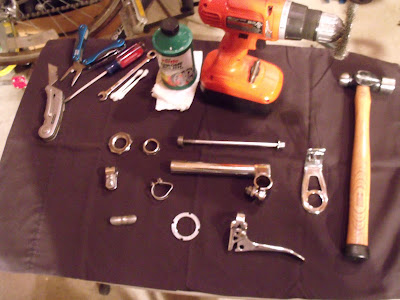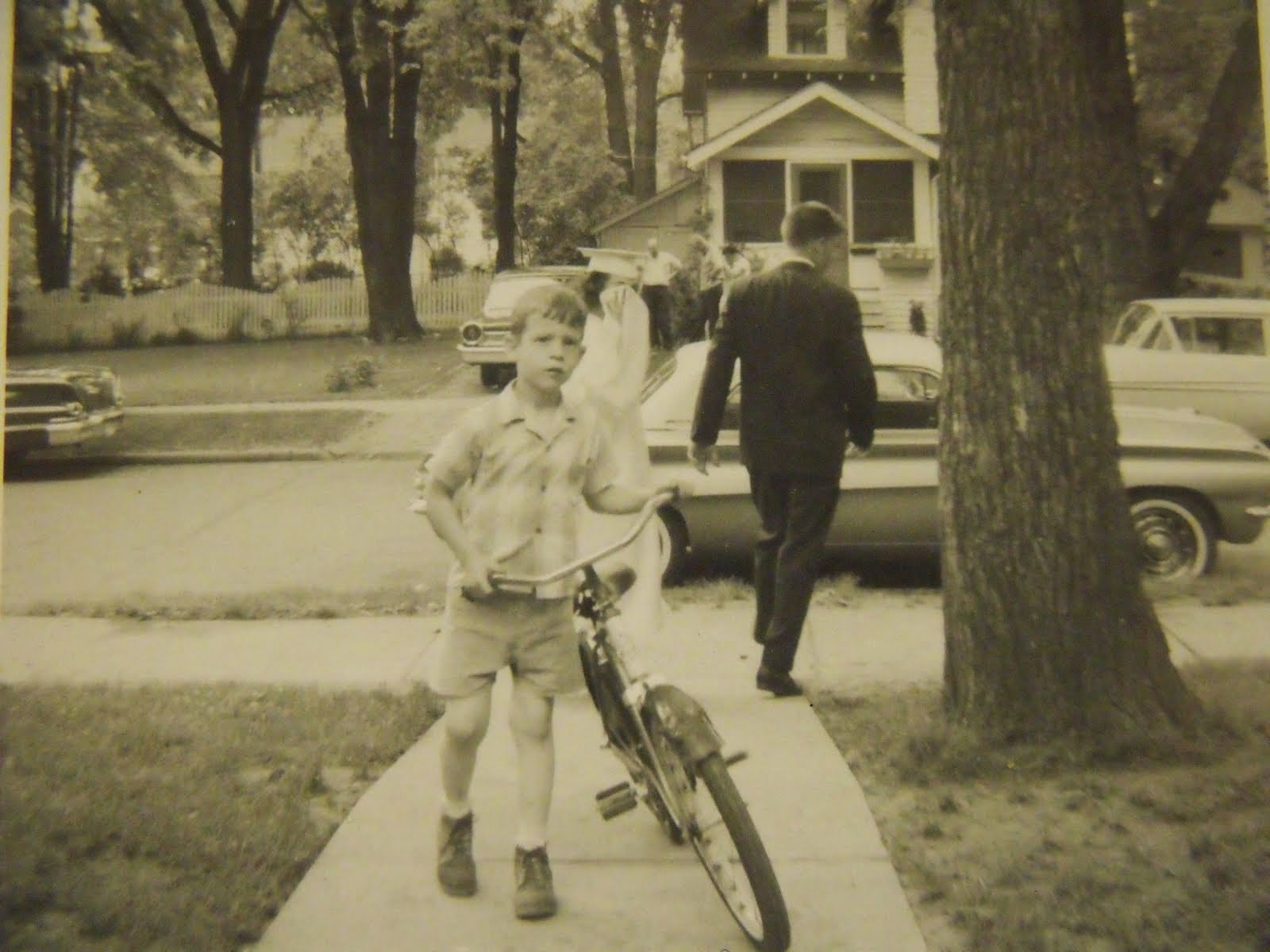Hello and Welcome,
Now that the dent and rust repairs are finished, I can finally get this old Raleigh Sports painted. When I left off I was going to touch up the filler on the fenders / mudguards just one more time.
Above: Here I have added another coat of Bondo Galzing /Spot Putty to the lower mud guards. I am hopeful this coat will finally give me the shape and finish I have been looking for.
Above: I cut this little filler and putty spreader from a larger one. This is about 1/6 of the original spreader size. This worked very well for filling the numerous small dents on the mud guards (fenders). I started with a 1/2 of a plastic spreader (3 x the width of this one) that I had heated up so I could shape it closer to the fenders bevels or curves. It worked ok but not great.
Above: After 2 filler layers and two or three spot filler layers I have finally got the fenders looking pretty close to their original shape. Now I can get get everything painted and start making some progress with this restoration.
Above: After getting the chain guard sanded and primed I touched it up with the spot putty and re sanded and sprayed the primer again. On my first attempt at painting this, the paint splattered due to a damaged nozzle stem. On my second attempt (new can) I over sprayed and the paint ran a bit in one spot. So I re-sanded and touched up the primer and tried again. The New Rust-Oleum "Professional Enamel" is a higher volume spray, it caught me totally off guard. After my third attempt I am finally satisfied with the finish on the guard. Now I can get on with the rest of it.
Above: After all the trouble I had with the chain-guard, I was probably over cautious with spraying enamel on the frame and fenders. After the first coat I let it dry for 48 hours before respraying. I gave it some extra time as the weather here has cooled off quite a bit. So now I will let these dry another three days before "ever so carefully" handling them.
Above: While the paint is drying I will use the time to clean and polish all the chrome. And also to wheel brush all the little nuts and bolts and other little pieces I am hoping to to reuse. The handlebars look pretty good for 48 years old. They are "nicked up" a bit but they still polished up pretty nice. So for now I plan to reuse them. None of the salvaged ones I saw on e bay looked any better to me.
Above: I am always amazed by how well old "good quality" chrome parts clean up. I expect I will need to replace all the little nuts and bolts for fender mounting etc. As they all look really rusty.
Here is a "before pic" of the lantern hanger bracket and stem. That green looking stuff on the stem turned out to be old Scotch Tape. That was a pleasant surprise, to say the least.
Above: I think for 48 years old, this lantern hanger bracket looks awesome! Just a few minor scrapes and some pitting. Just enough to give it some character. Overall it still looks and shines up pretty damn good.
Above: Click on this pic if you can for a close up. Here is a shot of the bent fender strut (black arrow) that I was able to straighten using the bench vise . But what I really want you to see is the (Red Arrows) fender mount bolts and nuts. I was 95% sure I would have to replace these.
Above: I cleaned these up using the fine brass wheel brush on the Black and Decker18V rechargeable drill/driver. This is the difference between good hardened steel and the rubbish that you find on cheaper bicycles today. These were not even chrome plated (maybe zinc plated) but they were pretty rusty so I can not be sure. Just amazing!
Above: I cleaned up the crank (on the bike) when I first bought it. And then again (with de-greaser) after removing it. So basically I just did a wee bit of brass detail brushing before polishing it up using the T-280RA Turtle Wax Chrome Polish & Rust Remover . I really love these old British Cranks with the makers logo built in. The old BSA cranks are really cool too!
Above: While waiting for the "Bondo" glazing and spot putty to cure, I mounted the new Kenda K40-HP Street Wire Bead Bicycle Tire, Gumwall, 26-Inch x 1-3/8-Inch on the reconditioned wheels. I also replaced the rim strips and installed new Kenda 26 inch inner tubes . I think these are going to look great. I do not think gum walls were original equipment on this bike, but I am not concerned about that. I just really like the way gum walls look on classic style bikes and I probably always will.
Above: I cleaned out my pliers/channel-locks /cutting tools drawer (temporarily) to keep track of all the parts as I clean them up. I will not be able to start reassembly until the new bearings arrive.
Above: Today (now that the paint is dry) I went ahead and did the Gold detail around the lugs. I probably over did it, but that's ok because I like it :) the paint is Testor's modeling paint Gold
Above: I finally decided to go ahead and paint the lower rear fender white. I made the curve by first placing a piece of 3M Scotch blue painters tape on a sheet of wax paper. Then I scribed the curve using a compass. Next I cut out the curve using an X-Acto knife . Then I was able to peel off the piece I needed and transfer it to the fender. Then I just taped off the rest of the fender and struts with newspaper and masking tape. Before spraying I did lightly sand the area (after taping) with 400 grit sand paper. Then wiped it clean of course. And I used Rust-Oleum 252467 Semi Gloss White Enamel over Enamel. You Do Not want to paint over enamel with lacquer....Ever.
Above: I thought I would show you some of the other cool stuff I have ordered for the Sports. I found this bicycle fender mount reflector on e bay the other night and could not resist. This should look really good just below the rear fender Raleigh decal.
Above: I ordered these cork grips . I am not liking the grips I already ordered and received all that much that. They look more like Schwinn grips than Raleigh. I will shellack these and they should look really good.
Above: I also ordered new 5/32 ball bearings 25 grade for the headset and the crank. I will not show both sizes, as they look pretty much the same.
Above: I also ordered this new Sturmey Archer 3 speed shift cable and housing which comes with all the necessary hardware. (or so they tell me)
Above: Here is my new incorrect Sturmey Archer 3 speed shifter . It matches the incorrect one that was on the bike when I purchased it perfectly. I may replace this eventually. Also I should mention I haven't a clue as to how this connects to the shift cable. I might have to check my bicycle repair book Park Tool Big Blue Book Of Bicycle Repair which I have rarely used. Except for to cut vinyl trim tape on the "wax paper like" cover.
Above: No I wasn't kidding. I am sure it is a fine book and I think I might have even used it once or twice. However in all honesty, my first resource is always the internet. If I think something is going to give me trouble, I`ll take the lap top out in the shop with me.
Above: These are not the pedal blocks I wanted. But they will have to do until I can locate a set of the genuine Raleigh blocks. They are the longer men's size blocks which may take me longer to locate. Also being an older model they do not have the reflectors. The pedals are also the old English tread which are getting harder to find at an affordable price.
Above: I was able to mount the rear mud-guard this afternoon. Today is Tuesday, I started this post Monday night. The white paint only had one evening to dry.
Above: I had a propane radiant heater going last night in the shop and a fan blowing on the fender as well. It dried really well for one evening. I think that we are all caught up with my progress so far. Unfortunately there is not much I can do now until the bearings arrive. Until next time Please RIDE SAFE and Remember to Always.......RESCUE, RESTORE & RECYCLE..........Cheers,Hugh
Above: Still my favorite Raleigh "so far" the 1970's Sprite. I hope the new owner has been taking good care of it.
ATTENTION AMAZON SHOPPERS! You can help Support This Blog by simply logging onto Amazon dot com using the "Amazon Search Box" located in the Top Right Corner of This Page. It will not effect your cost and I will receive a very small commission. Thanks for Your Support. Cheers
Outdoor Ventures Packable Jacket Review
2 weeks ago
























































